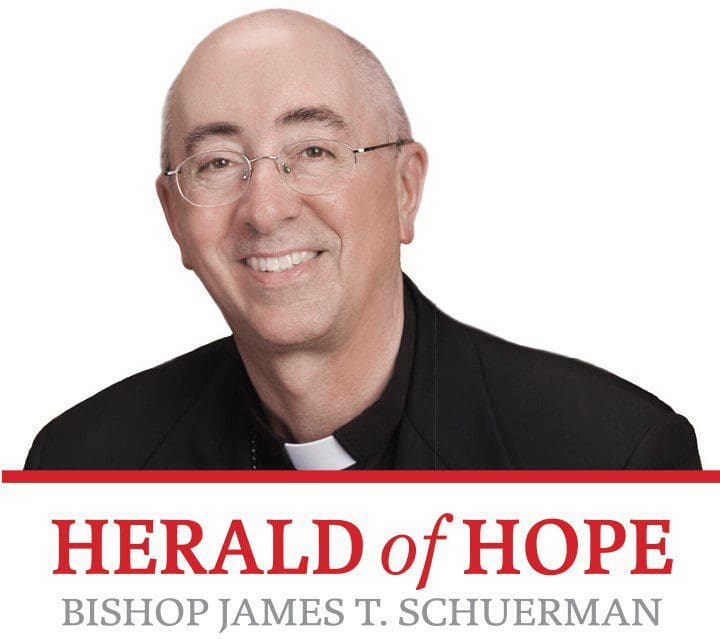Herald of Hope
Bishop James T. Schuerman was one of four clergy leaders of the recent Archdiocese of Milwaukee pilgrimage to the National Eucharistic Congress in Indianapolis. In this Herald of Hope, Bishop Schuerman reflects on some questions posed by the Catholic Herald.
What stands out as having the biggest impact on you from the National Eucharistic Congress?
I was impressed by the great number of people who attended the Eucharistic Congress and the love that the people demonstrated in their participation in the celebration of the Eucharist, their deep sense of devotion in Eucharistic Adoration and their enthusiasm in the outdoor Eucharistic procession.
I found many of the talks to be inspiring and enlightening, especially the talks by Cardinal Christophe Pierre, Fr. Michael Schmitz, Gloria Purvis and Bishop Robert Barron. Each one gave insights on different dimensions of the Eucharist and what it means to be a Eucharistic people — faith in the Real Presence, unity, mission and societal change. However, it was even more impactful for me to observe how the people responded to these talks with excitement and energy.
I was particularly moved by the dynamics of the Eucharistic procession. There was, of course, a great show of love and devotion for the Blessed Sacrament as it passed by the crowds lining the street. Additionally, there was a lot of warmth and affection shown to the deacons, priests and bishops as they processed. Individuals from the crowds called out things like, “Thank you for your service to the Church,” and “Thank you for your leadership.”
When you’ve had a chance to discuss the congress with any of the archdiocesan pilgrims, what stands out in your mind about what they said?
In my interactions with fellow pilgrims, there are a couple of themes that stood out to them about the National Eucharistic Congress. One thing was the sense of awe and wonder of being in Lucas Oil Stadium with 60,000 faithful Catholics sharing the same belief in the Real Presence of Jesus in the Eucharist — Body, Blood, soul and divinity. It was a demonstration of faith on a massive scale, and it inspired and energized individual pilgrims.
Another theme that came up in my conversations with fellow pilgrims was that of the diverse, multicultural nature of the event. There were liturgical options held in English, Vietnamese and Spanish. There were also Eastern Rite liturgies, such as the Byzantine Divine Liturgy and the Syro-Malabar Qurbana. At the closing Mass of the congress, Cardinal Luis Antonio Tagle greeted the congregation in 11 different languages, receiving an enthusiastic response from members of each language group.
How would you recommend that Catholics go out on mission to share their faith, especially their faith in our source and summit, the Eucharist?
The liturgical celebration of the Eucharist is truly the summit and source of our lives as Catholic Christians. At the Eucharistic congress, the pilgrims experienced a summit experience of the Eucharist — a sense of wonder and awe in the transcendent reality of the presence of Christ, life-giving nourishment in Holy Communion, and a spirit of love and friendship among the multitude of faithful pilgrims.
This kind of summit experience — this sense of being on the mountaintop with God — should be a transforming experience, changing individuals and helping them to be more faithful, more loving, more merciful and more compassionate. This change must be reflected in the way they live their lives — being more patient and understanding with family members, more willing to witness to the love of Jesus among friends and co-workers, and more eager to serve those in need. The opportunities to draw from the Eucharistic source of Christian life are countless. The call is to be more Christ-like in the midst of everyday activities, and to be willing to reach out to be of service to others.
Do you have anything to say about the Walk with One initiative referenced by a couple of congress speakers?
The beauty of the Walk with One initiative is its simplicity. It is an evangelization effort that focuses on one person and uses four simple stages. The first is “Identify,” in which a person asks God to point out an individual to accompany on a journey of faith. The second is “Intercede,” which involves praying for that individual. The third is “Connect,” looking for ways to build a relationship with that individual. And the fourth stage is “Invite,” inviting the individual to take the next step in the faith journey when the time is right; for example, coming to a prayer group or participating in the celebration of the Mass.
I find this to be a very positive approach to evangelization because it involves building relationships and providing accompaniment to others in their life journey, helping to awaken in them their need for God’s friendship and love.
Find out more about Walk with One at eucharisticrevival.org/walk-with-one.

